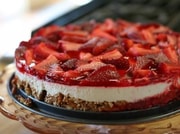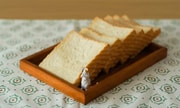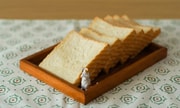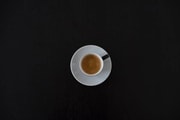Why people are still painting porch ceilings blue—and the reason might surprise you
- Replies 1
In quiet neighborhoods across the South, one design detail stands out.
It’s not the grand wraparound porches, the wicker chairs, or the hanging plants—it’s what’s overhead.
For generations, porch ceilings in these parts have been painted a very specific color: a pale, sky-like blue.
And while many locals know the reason, others—especially newcomers—are only now beginning to understand the story behind the paint.
It’s more than just a design choice. The tradition of painting porch ceilings blue—commonly called haint blue—can be traced back to the 1800s.
It’s rooted in the beliefs of the Gullah Geechee people, descendants of enslaved Africans in parts of coastal South Carolina and Georgia. They believed in spiritual entities known as “haints,” which were said to cause mischief or harm.
According to folklore, these spirits could not cross water. So homes were painted in watery shades of blue—especially ceilings, door frames, and shutters—to keep spirits from entering.
Haint blue was meant to confuse the ghosts into thinking the ceiling was the sky or a body of water. This belief system has been passed down through generations, and in some Southern towns, you’ll still find porches marked by the same soft hue.
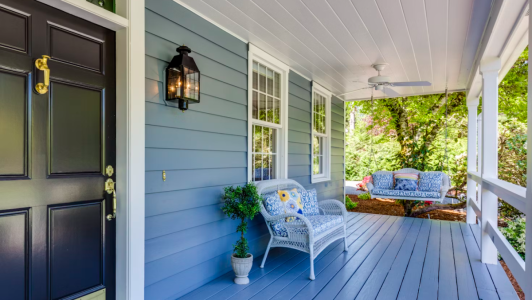
But today, the reason behind the paint job has expanded beyond the supernatural. Many residents say the color also helps keep unwanted pests away. Bees, wasps, and spiders are reportedly less likely to build nests on ceilings painted in pale blue.
Just as with the haints, the idea is that insects mistake the blue surface for the sky and steer clear. Is there any science behind it? That depends on who you ask.
Some pest control professionals claim it’s a tip they recommend to homeowners.
“As a pest control technician I tell my customers about this all the time. It isn't full proof but it does help a lot.”
Another added, “Painting it blue really does help. It's not an end all solution but it's a drastic improvement.”
Still, entomologists aren’t fully convinced. According to Dr. Michael Reiskind, an entomology professor at North Carolina State University, the effect may not be what people think.
“I doubt any colors are very repellant to insects, except in very specific situations,” he explained. Dr. Reiskind believes that some colors are simply less attractive than others, rather than being active repellents.
“What is more common is that there are colors that are attractive to particular insects, including some shades of blue for flies, but color repellency is not well-supported,” he said.
He added that color repellency isn’t well supported by science—visual repellence is “likely quite rare.”
Even so, the blue ceilings have persisted, both for practical and sentimental reasons.
Also read: Amazon’s 10-Minute tiny home is changing everything—could you own one?
For many, the color is comforting.
It’s a visual link to family memories and long-standing traditions.
As Ellen O’Neill of Benjamin Moore explained, “No one would think twice about painting their porch blue, because their grandmother’s and their parents’ [porches] were blue.”
She added, “It’s permeated into porch design.”
Sue Wadden of Sherwin-Williams noted the calming effect of the shade: “People paint the porch ceiling blue because the color seems to emulate the natural sky and makes daylight hours feels as though they last just a little longer.”
That effect—whether real or imagined—can make a porch feel more open, cool, and inviting. In many Southern homes, that alone is reason enough to keep the ceiling blue.
One online video recently went viral as users discussed painting their own porch ceilings. One creator shared that they painted their porch blue after moving to Florida from Louisiana, claiming it helped reduce spiders and wasps.
Another commented, “We have done the same front and back porch learned it from Louisiana and I'm in Florida. Works well.”
A third chimed in, “Sometimes us Southerners know a thing or two.”
Whether it’s about deterring bugs, warding off spirits, or simply upholding tradition, haint blue has taken on a life of its own. If you’re considering adopting the trend, it’s worth knowing what you’re getting into—and what shade you might choose.
Also read: The surprising trend changing neighborhoods—and what it could mean for you
There’s no single, official formula for haint blue. Some choose pale robin’s egg; others prefer deeper sky tones.
What matters most is choosing something that feels airy and open, like a stretch of early morning sky. And if you’re ready to paint, there are a few tips to help make the job easier.
Start by cleaning the ceiling and fixing any cracks or peeling areas. Apply a primer to ensure the color adheres and holds up to weather. Use an exterior-grade paint in satin or semi-gloss for added durability and light reflection.
A roller works for large areas, while a brush is best for edges and corners. Two coats usually do the trick. Once you’re done, sit back with a cold drink and admire your handiwork—spirits and bugs not invited.
In the end, it’s more than just a coat of paint. The blue ceiling tells a story—of culture, resilience, comfort, and charm.
Whether you believe in ghosts, bugs, or neither, it’s a way to keep a Southern tradition alive. And sometimes, the smallest things carry the deepest meaning.
Read next: Older generations spill the beans: Home trends that absolutely infuriate them – Do you agree?

Have you ever noticed a blue porch ceiling in your neighborhood—or painted one yourself? Do you think it keeps bugs away, or do you just love the look and tradition? Share your thoughts and memories with us in the comments—because sometimes, a little color carries a whole lot of history.
It’s not the grand wraparound porches, the wicker chairs, or the hanging plants—it’s what’s overhead.
For generations, porch ceilings in these parts have been painted a very specific color: a pale, sky-like blue.
And while many locals know the reason, others—especially newcomers—are only now beginning to understand the story behind the paint.
It’s more than just a design choice. The tradition of painting porch ceilings blue—commonly called haint blue—can be traced back to the 1800s.
It’s rooted in the beliefs of the Gullah Geechee people, descendants of enslaved Africans in parts of coastal South Carolina and Georgia. They believed in spiritual entities known as “haints,” which were said to cause mischief or harm.
According to folklore, these spirits could not cross water. So homes were painted in watery shades of blue—especially ceilings, door frames, and shutters—to keep spirits from entering.
Haint blue was meant to confuse the ghosts into thinking the ceiling was the sky or a body of water. This belief system has been passed down through generations, and in some Southern towns, you’ll still find porches marked by the same soft hue.

In quiet neighborhoods across the South, one design detail stands out: the color blue. Image Source: Francesca Tosolini / Unsplash
But today, the reason behind the paint job has expanded beyond the supernatural. Many residents say the color also helps keep unwanted pests away. Bees, wasps, and spiders are reportedly less likely to build nests on ceilings painted in pale blue.
Just as with the haints, the idea is that insects mistake the blue surface for the sky and steer clear. Is there any science behind it? That depends on who you ask.
Some pest control professionals claim it’s a tip they recommend to homeowners.
“As a pest control technician I tell my customers about this all the time. It isn't full proof but it does help a lot.”
Another added, “Painting it blue really does help. It's not an end all solution but it's a drastic improvement.”
Still, entomologists aren’t fully convinced. According to Dr. Michael Reiskind, an entomology professor at North Carolina State University, the effect may not be what people think.
“I doubt any colors are very repellant to insects, except in very specific situations,” he explained. Dr. Reiskind believes that some colors are simply less attractive than others, rather than being active repellents.
“What is more common is that there are colors that are attractive to particular insects, including some shades of blue for flies, but color repellency is not well-supported,” he said.
He added that color repellency isn’t well supported by science—visual repellence is “likely quite rare.”
Even so, the blue ceilings have persisted, both for practical and sentimental reasons.
Also read: Amazon’s 10-Minute tiny home is changing everything—could you own one?
For many, the color is comforting.
It’s a visual link to family memories and long-standing traditions.
As Ellen O’Neill of Benjamin Moore explained, “No one would think twice about painting their porch blue, because their grandmother’s and their parents’ [porches] were blue.”
She added, “It’s permeated into porch design.”
Sue Wadden of Sherwin-Williams noted the calming effect of the shade: “People paint the porch ceiling blue because the color seems to emulate the natural sky and makes daylight hours feels as though they last just a little longer.”
That effect—whether real or imagined—can make a porch feel more open, cool, and inviting. In many Southern homes, that alone is reason enough to keep the ceiling blue.
One online video recently went viral as users discussed painting their own porch ceilings. One creator shared that they painted their porch blue after moving to Florida from Louisiana, claiming it helped reduce spiders and wasps.
Another commented, “We have done the same front and back porch learned it from Louisiana and I'm in Florida. Works well.”
A third chimed in, “Sometimes us Southerners know a thing or two.”
Whether it’s about deterring bugs, warding off spirits, or simply upholding tradition, haint blue has taken on a life of its own. If you’re considering adopting the trend, it’s worth knowing what you’re getting into—and what shade you might choose.
Also read: The surprising trend changing neighborhoods—and what it could mean for you
There’s no single, official formula for haint blue. Some choose pale robin’s egg; others prefer deeper sky tones.
What matters most is choosing something that feels airy and open, like a stretch of early morning sky. And if you’re ready to paint, there are a few tips to help make the job easier.
Start by cleaning the ceiling and fixing any cracks or peeling areas. Apply a primer to ensure the color adheres and holds up to weather. Use an exterior-grade paint in satin or semi-gloss for added durability and light reflection.
A roller works for large areas, while a brush is best for edges and corners. Two coats usually do the trick. Once you’re done, sit back with a cold drink and admire your handiwork—spirits and bugs not invited.
In the end, it’s more than just a coat of paint. The blue ceiling tells a story—of culture, resilience, comfort, and charm.
Whether you believe in ghosts, bugs, or neither, it’s a way to keep a Southern tradition alive. And sometimes, the smallest things carry the deepest meaning.
Read next: Older generations spill the beans: Home trends that absolutely infuriate them – Do you agree?
Key Takeaways
- Painting porch ceilings haint blue began in the 1800s with the Gullah Geechee people to ward off spirits.
- Many Southerners believe the light blue color deters insects, though scientific evidence is inconclusive.
- Experts say the paint may be less attractive to bugs, not a true repellent.
- The tradition continues today for practical, cultural, and nostalgic reasons.


